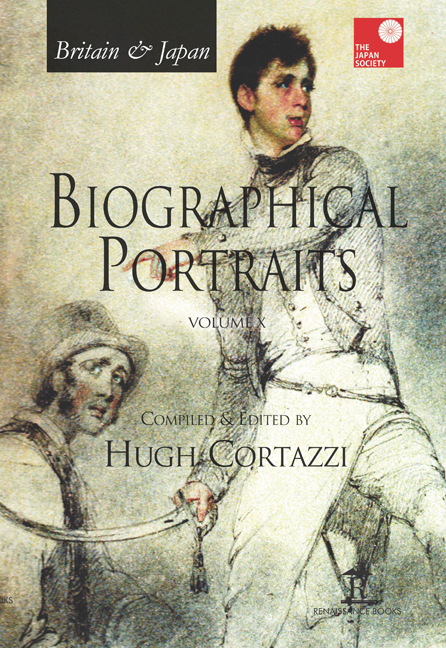Book contents
- Frontmatter
- Dedication
- Contents
- Introduction
- List of Contributors
- Index of Biographical Portraits in Japan Society Volumes
- PART I BRITAIN IN JAPAN
- PART II JAPAN IN BRITAIN
- Select Bibliography of Works in English on Anglo-Japanese Relations [Compiled by Gill Goddard – Retired East Asian Studies Librarian, University of Sheffield]
- Select Bibliography of Works in Japanese on Anglo-Japanese Relations [Compiled by Akira Hirano, SISJAC]
- Index
24 - John Frederick Lowder (1843–1902): Consul, Counsel and o-yatoi
Published online by Cambridge University Press: 07 May 2022
- Frontmatter
- Dedication
- Contents
- Introduction
- List of Contributors
- Index of Biographical Portraits in Japan Society Volumes
- PART I BRITAIN IN JAPAN
- PART II JAPAN IN BRITAIN
- Select Bibliography of Works in English on Anglo-Japanese Relations [Compiled by Gill Goddard – Retired East Asian Studies Librarian, University of Sheffield]
- Select Bibliography of Works in Japanese on Anglo-Japanese Relations [Compiled by Akira Hirano, SISJAC]
- Index
Summary
NOW LARGELY FORGOTTEN, J.F. Lowder was a prominent member of the foreign community in Japan from its earliest days until his death. He was born in Shanghai, where his father, the Rev. John Lowder, was the Anglican chaplain to the newly opened consulate. Rutherford Alcock (later Sir Rutherford), first British consul at Shanghai, married John Lowder's widow in July 1862, when he was minister in Japan. It was the Alcock connection that led to J.F. Lowder becoming one of the first language students in June 1860. He performed well in the attack on the British legation in Tozenji in July 1861 but escaped being wounded. Soon after, he completed his language training and began his consular career.
He was soon married, not perhaps a planned move. Ernest Satow noted in his diary for 9 September 1862, the day after he had arrived in Japan, that he had met Lowder at the house of the American missionary Rev. S.R. Brown. He described him as ‘a pale mealy-faced fellow, who it appears seduced Miss Brown last December, and has now come down from Hakodadi (sic), to be married …’ Brown was devastated by this development, while the new Lady Alcock apparently disapproved of the marriage not because of the seduction but because Miss Brown was an American and not aristocratic.
Like his colleagues, Lowder moved from one acting appointment to another as required, until he was gazetted as consul at Nagasaki in January 1869. The following year, Parkes allowed him to take home leave, noting that he wished to read for the Bar. Permission was granted. He qualified in 1872 and returned to Japan. Soon after his return, the Japanese authorities at Yokohama approached the British chargé d’affaires R.G. Watson (Parkes was on leave) asking that Lowder be seconded to help arrange a new system of customs’ duties, to replace those operated under the bakufu. It seems likely that Lowder himself had put the idea to the Japanese. Watson referred the case to London, noting that while this might have advantages for British merchants, similar cases in China had led to protests.
The request was refused. Lowder said he could not meet his liabilities on his consular salary, since what seemed a large salary in Britain ‘leads to a life of penury and debt in Japan’.
- Type
- Chapter
- Information
- Britain & Japan Biographical Portraits Vol X , pp. 300 - 302Publisher: Amsterdam University PressPrint publication year: 2016

